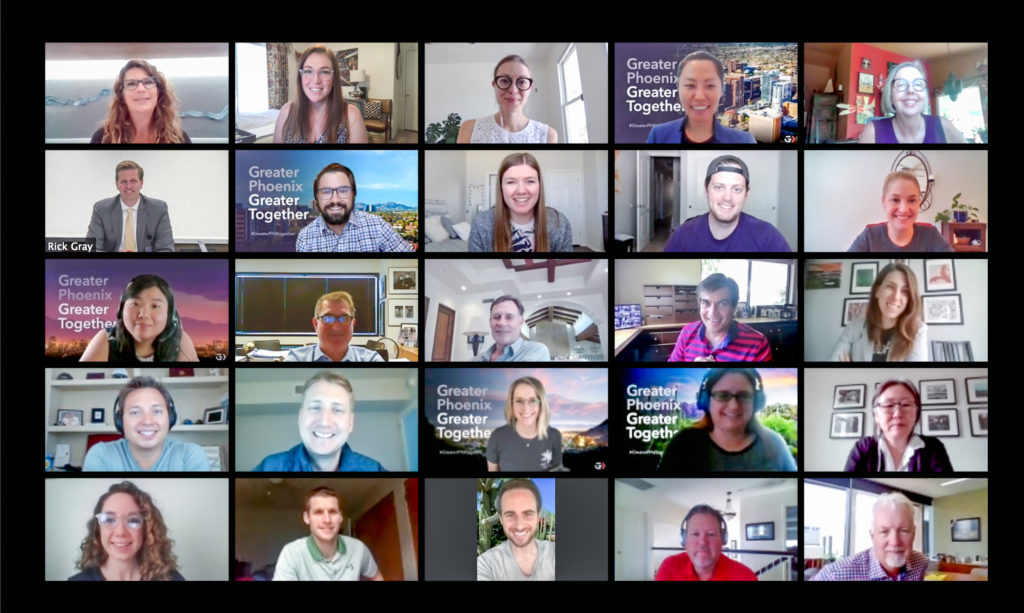

Fireside Chat: Mayo Clinic’s pivot at the start of COVID-19, reducing risk with innovation
Published: 05/29/2020
Due to COVID-19, every industry across has faced the overwhelming decision to pivot their business model. Healthcare is arguably steering the strongest transition, and hospitals in Greater Phoenix like Mayo Clinic, are leading the way with quick action and innovation.
Mayo Clinic is a nonprofit organization committed to clinical practice, education and research. According to Mayo, every year, more than a million people from all 50 U.S. states and nearly 150 countries around the world come to Mayo for care. The Mayo Clinic in Arizona has been named the No. 1 hospital in the state and one of the top 20 hospitals in the nation for three consecutive years by U.S. News & World Report.
Dr. Richard Gray, M.D., FACS, CEO of Mayo Clinic in Arizona, recently joined us for a virtual Fireside Chat. He shared how Mayo is reducing the risk of COVID-19 in the state, by prioritizing innovation, and shared insights on keeping businesses and individuals safe as the economy reopens.
Arizona hospital capacity and Mayo Clinic’s quick pivot
Dr. Gray expressed that Arizona’s hospital capacity is strong because of the steps local hospitals like Mayo took from the start.
“Instead of sitting and waiting, we said we have to prepare and innovate,” said Dr. Gray. “That’s the attitude that we are taking. We have to learn how to effectively be Mayo in a COVID–19 world. I would hope that is more and more the attitude everyone is taking.”
Not only did Mayo open the first COVID-19 drive through testing site in the state, they have been actively trying to deploy their testing to others, including the Gila River Indian Reservation and the Navajo Nation. From the start, Mayo published their best processes, safety practices and treatment algorithms so all Arizona hospitals have access to that information. Mayo is working on a few different solutions to make COVID-19 testing easier, including research trials of a drug that was initially developed for another purpose, Dr. Gray said.
He touched on a few strategies that Mayo has adopted to keep their employees and visitors safe including:
- Conducting serology testing of employees
- Monitoring all employees’ symptoms and temperatures twice a day
- Requiring every patient and visitor to wear masks
- Requiring doctors and nurses interacting with patients to wear masks and eye protection
- Utilizing cohort units that can ensure any air in a COVID-19 patient’s room doesn’t get into other parts of the hospital as it cycles through filters
How COVID-19 advanced the use of HealthTech
The pandemic has brought change to the way people work and, in many instances, this isn’t a negative outcome. Dr. Gray pointed to the two biggest changes we have seen in the workplace:
- Telework: “We found that we can make it work though telework pretty well.”
- Telehealth: “It was part of our plan, like many others, to accelerate telehealth. We didn’t think it would be a pandemic that would cause that.”
In 2019, Mayo was conducting roughly 1,000 video exams a year. Since the pandemic, they are conducting about 2,000 a day. Dr. Gray said Mayo’s telehealth success has been remarkable and this is due to the infrastructure they already had in place.
“We knew it was the right thing to do, but it’s hard with inertia,” Dr. Gray said about telehealth. “There is a certain way patients and doctors have always done it. Sometimes it’s an awful event like this that pushes us into some good things as well.”
Consumer confidence and keeping people safe
Dr. Gray pointed to the importance of consumer confidence when it comes to successfully reopening the economy.
“There is going to be a certain set of people that will come out to your business no matter what in all of this,” Dr. Gray said. “But if you are not doing the right things to make sure your employees and your customers are safe, there is going to be a good segment of the population that won’t have the confidence to patronize your business after a while.”
In the process of reopening businesses, Dr. Gray discussed how to decrease high risk encounters for employees and patrons. He pointed to the following factors that should be addressed:
- Physical Distancing: “How close do individuals come into contact with each other? At six feet apart, you are less likely to be exposed to droplets. The louder an environment is, the more people shout and lean into each other, which increases risk of droplet exposure.”
- Masking: “If one person is masked, it does decrease the risk at least to the other person because the person masked won’t expose their droplets. If both people are masked, even if you are within six feet and shouting, the exposure is low.”
- Education: “We will have to keep working on education on those exposure and risk levels. I think it’s important to have employees review the symptom list, monitor temperatures and stay home if they experience the symptoms.”
Dr. Gray’s key advice for employees returning to the workplace, specifically offices, is that ‘this is the time to innovate.’
He pointed out that employers can control the safety of their own office space, including how often they use telework. If remote work doesn’t make sense as a long-term solution for some or most employees, Dr. Gray advises business leaders to find ways to make the workplace safer. He said this can include universal masking, putting barriers in place between desk space and reconfiguring the office to provide better social distancing.
Mayo’s plans outside of COVID-19
Mayo’s plans to innovate don’t stop at the cost of a global pandemic. On top of doubling the size of their Phoenix campus, Dr. Gray said Mayo’s emphasis remains in direct research of complex care. They will continue this work by:
- Deploying ways to unburden doctors and nurses so they have more time to physically spend with patients
- Simplifying healthcare with their research platform that other healthcare institutions can access
- Accelerating home hospitalization
Leaders like Mayo are one of the many reasons Greater Phoenix has become a HealthTech hub. Learn more about the region’s healthcare and biomedical industry here.
